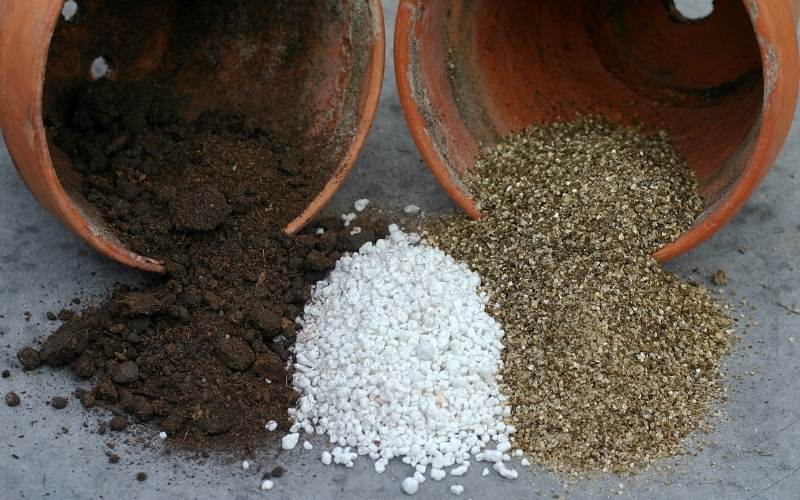
Vermiculite and perlite are common gardening materials used to improve soil, potting mix or growing mediums as a soil amendment. The names sound similar, and many people may think they are basically the same.
But they are not. Perlite and vermiculite are quite different in composition and also performance wise. There are some key differences you need to know before you choose the one that you really need. Perlite vs. vermiculite. what’s the difference?
Vermiculite and perlite are both porous rocks, but they are quite different in composition as their uses:
Both, however, hold both water and air, but at different rates. Finally, there are also other minor differences in pH and nutrients they hold.
If you want to become a real pro when it comes to vermiculite and perlite, you need to Determine which is better for use in your garden depends on your plant type and its requirements.
And this guide, we are going to learn everything about these two materials: how they originate, what they look like, how they are different, how and when to use them in gardening (indoors and outdoors), and which is better for what need!
Are Vermiculite And Perlite The Same, Or What Are The Differences?
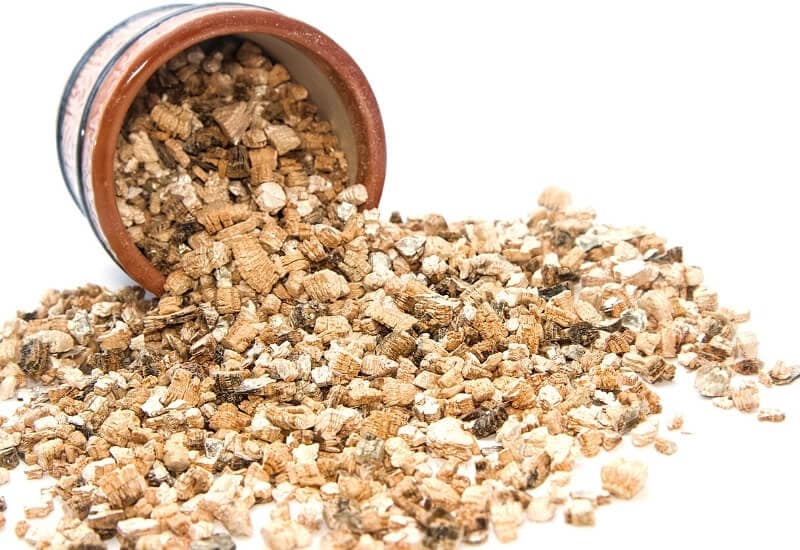
Vermiculite and perlite are often mentioned together, and they sound similar, but they are not the same. Both are used to improve the soil.
In particular, both make the soil better drained and better aerated. But this is where the similarity ends.
Vermiculite holds water better than perlite and conversely perlite holds air better than vermiculite. This is the key difference between the two. You will use vermiculite to make sure that the soil is well drained but still holds on to water. On the other hand, if you want perfect aeration and you want the soil to dry up well, perlite is better option.
For example, perlite is better for succulent plants and cacti, because they don’t want humidity in the soil. Vermiculite instead is good with moisture loving plants, like ferns and many rainforest houseplants (pothos, philodendron etc.). And you may use vermiculite if you can’t water your plants as frequently as you should.
There are also other minor differences, in appearance, in pH in cost for example, but we will see them later on.
A Bit Of Mineralogy: Where Vermiculite And Perlite Come From
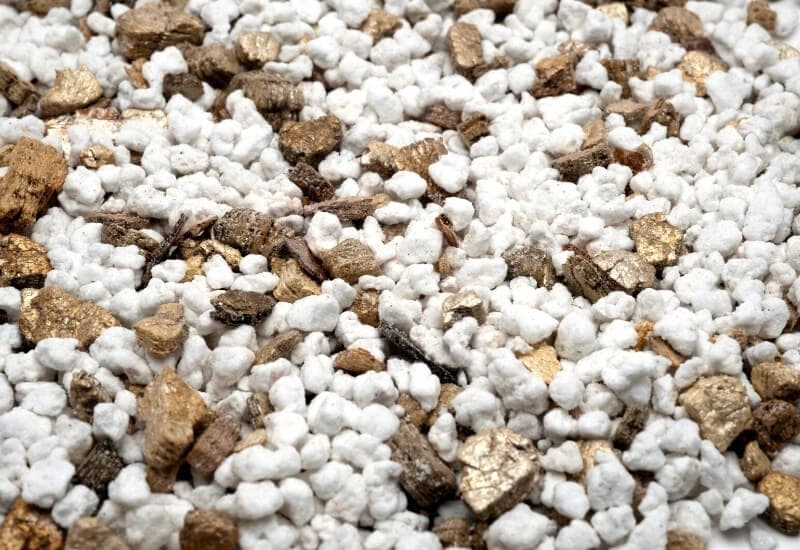
Both vermiculite and perlite are, technically speaking, minerals. In common terms, we would define them more as “rocks” or “stones”, but minerals are a world of their own, and each mineral has its own origin, or formation process.
Where Vermiculite Comes From And How It Is Produced?
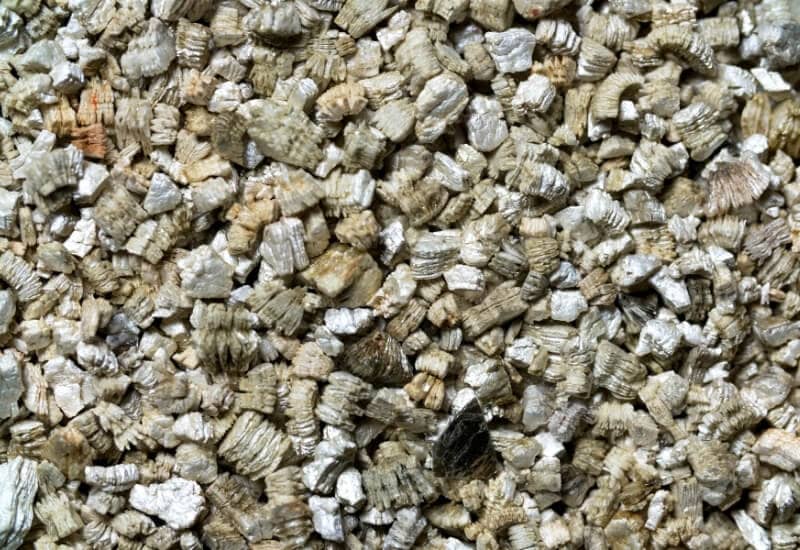
Vermiculite is a crystal that was first discovered in Massachusetts in 1824. It is called so from the Latin vermiculare, which means “to breed worms”. That’s because when it’s heated it exfoliates in a way that looks as if it gave birth to worms.
It is actually originates from clay, which modifies until it becomes a mineral rock. This rock, thanks to its composition can expand when heated. As it does this, it fills with pockets that can fill with air, water or, in hydroponic gardening, the nutrient solution.
The vermiculite we use in gardening is not what you would find in a quarry; it is then treated, which means that it is heated and exfoliated in professional furnaces.
These are tube furnaces, with a conveyor belt in it and which carries the vermiculite rocks. Here they are heated at 1,000oC (or 1,832oF) for a few minutes.
The main producers of vermiculite nowadays are Brazil, China, South Africa and the USA. It is not just used in gardening, but in the building industry and for fireproofing as well.
Where Perlite Comes From And How It Is Produced?
Perlite instead comes from volcanoes. Its main element is silicon. It forms through heating and compression of volcanic rock, when it heats into magma and changes its internal structure.
Perlite is actually a type of volcanic glass. But this glass has a particular quality: when it forms, it traps inside itself a lot of water.
So, after they quarry it, it gets heated at very high temperatures (850 to 900oC, which is 1,560 to 1,650oF).
This makes the water expand, and the perlite too expands a lot, becoming between 7 and 16 times as big as the natural rock.
But when this happens, it loses all the water inside and this leaves lots of empty spaces, gaps. This is why the perlite we buy is porous.
Perlite is very useful in many fields, and only 14% of it is used for gardening and horticulture. 53% of all perlite in the world is used in the building and construction business.
It is non renewable, so its price has been rising steadily. At the same time, people have looked for substitutes, like diatomite, shale, expanded clay or pumice.
Key Difference Between Perlite and Vermiculite
In terms of production, perlite is a popped stone, a bit like popcorn, while vermiculite is an expanded and exfoliated stone.
This means that it swells but at the same time it leaves shreds of starting from the outer layers and moving towards the core of the mother rock.
The Appearance Of Perlite And Vermiculite
Of course, what you need to know to recognize them is what they actually look like. And here we are going to see them.
The Appearance Of Perlite
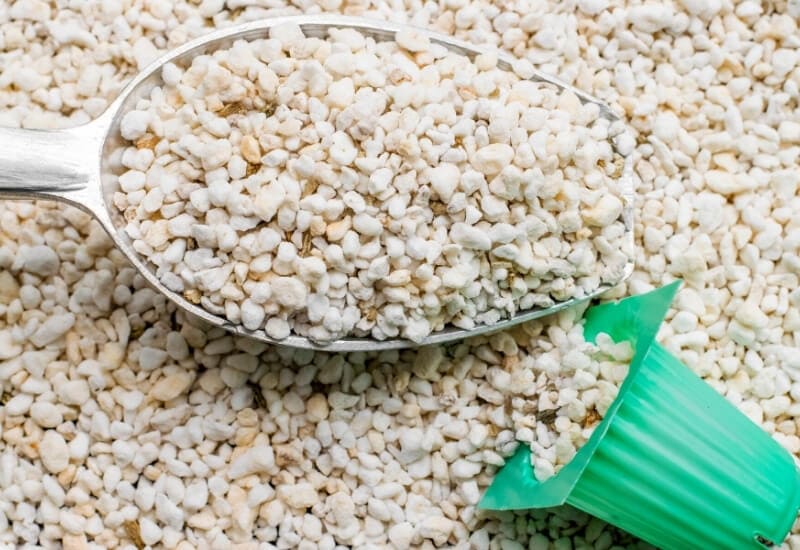
Perlite takes its name from the Latin perla, or, you guessed, “pearl”, in fact, it has that off white color we identify these maritime jewels with. It is dusty, and while it is a rock, it has a certain “softness” in its looks.
If you look at perlite at close range, it will look like a porous surface, or a surface with holes and craters in it. Perlite pebbles have a rounded appearance, with soft edges.
The Appearance Of Vermiculite
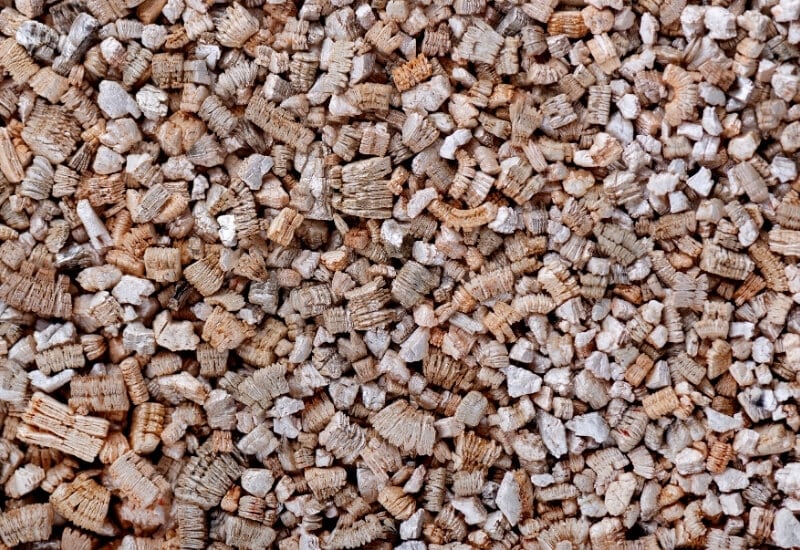
In its original form, vermiculite is almost black and shiny, with light colored veins across the stones. Once it has been heated and popped, however, it changes appearance.
It is not white, but usually of soft pastel colors on the brown, yellowish brown and khaki range. It is not dusty like perlite, instead it kooks like rocks.
If you look at vermiculite at close range, you will see that vermiculite is made up of may thin layers, this is exactly why it holds on to water so well. It filters through those fissures and it is retained there.
Vermiculite pebbles have a “squared” appearance; they are not rounded, bit they look a bit edgy and with straight lines. On the whole, they may remind you of small fossilized accordions.
Not Just a Matter of Look
But perlite and vermiculite have similar but different uses in gardening, it is not just a matter of choosing a color or texture.
Perlite and vermiculite are used to improve soil, potting soil or even growing mediums. One of their key functions is to break down heavy soil.
Very often, you see, soil can get “clumpy” especially if it is chalk or clay based. This is not good for the roots of plants, so, we add things like gravel, sand, coconut coir or one of our protagonists, perlite or vermiculite to break it down.
But perlite and vermiculite are not just like gravel. Gravel does not have the water and air retention qualities of perlite and vermiculite, nor other minor qualities we are going to see…
Next, then, the big difference: water!
How Well They Hold Water In The Soil
Both perlite and vermiculite hold on to water, which is different from sand or gravel. They act more like little “reservoirs” of water which they release slowly. But there is a very important difference.
Perlite And Water Retention
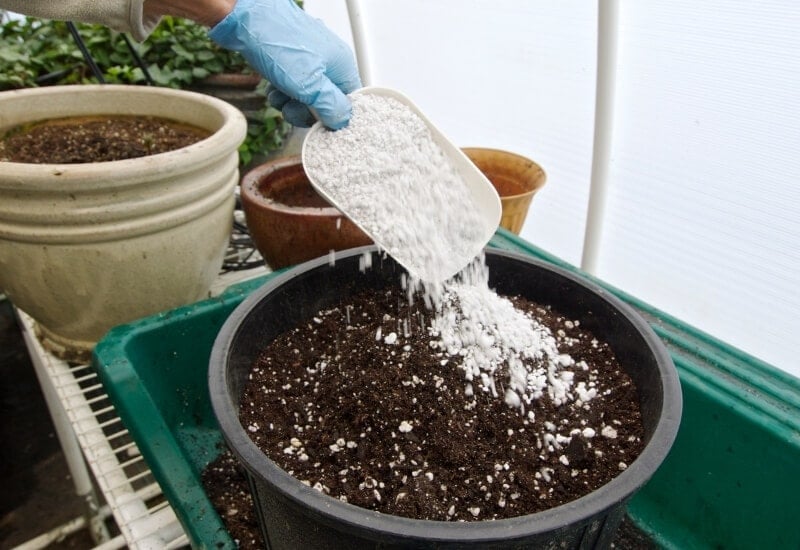
Perlite holds on to some water, but only on the outside. Because of the little crannies and craters on its surface, some water gets caught there. So, perlite holds on to little water, but it mainly allows it to slide off.
This means that perlite is very good for drainage, but it is not excellent for water retention.
For this reason, perlite is very good for dry loving plants, like succulents. It improves the soil, making it well drained, but it does not hold on to much moisture. As you know, cactuses and succulents don’t like humidity.
Vermiculite And Water Retention
Vermiculite has a different structure, as we said. It works a bit like a sponge, absorbing water inside. In fact, if you touch it after you have watered it, you will feel it is spongy and partly softish. It also expands when you add water to it. It becomes 3 to 4 times its size.
Then vermiculite releases the water it absorbs very slowly. For this reason, vermiculite is better if you want to improve the irrigation, irroration and, in general, watering and humidity of the soil.
When it comes to hydroponics, vermiculite is very useful indeed, because it optimizes the release of nutrients to your plants, making it slow, steady and prolonged through time.
Because it retains moisture so well, vermiculite is used to propagate plants by seed or through cuttings.
Young plants are very susceptible to even minor drops in humidity and soil moisture. So, vermiculite is one of your best friends here.
How They Hold On To Air In The Soil
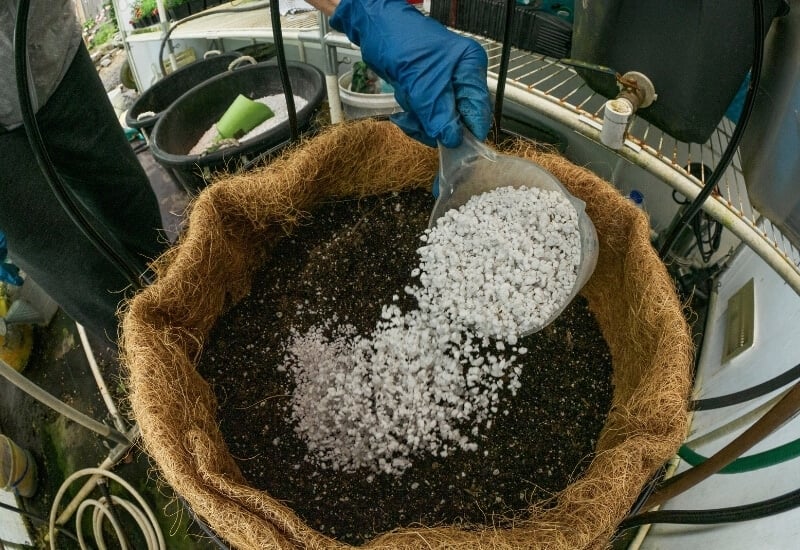
Talking of perlite and vermiculite, do know what happens if the roots of plants don’t have enough air? They literally suffocate! Yes, because roots need to breathe, literally, and if they don’t, they start rotting away.
So, the differences between perlite and vermiculite become important.
Perlite And Air Retention
Perlite is excellent to aerate the soil. On the one hand, true, it does not hold on to water and liquids too well. On the other hand, all the pores inside the pebbles get filled with air! This means that each perlite pebble is like a “lung” a “breathing aid” or an air pocket.
And it does hold on to lots of air! In fact, 88.3% of perlite is pores… That means that most of the pebble will become an air pocket. In this respect, perlite is absolutely the best material you can get to let your plants’ roots breathe.
This makes perlite ideal to lighten heavy soil and improve drainage. For succulent plants, plants that do not like soggy soil, plants that are at high risk of root rot, perlite is just excellent.
Vermiculite And Air Retention
On the other hand, vermiculite does not hold on to air as well as perlite. When it is wet, it swells, but when the water dries up, its shrinks back. So all the volume it had to hold on to water simply disappears.
It does provide some form of aeration, mainly insofar as it breaks down the soil and allows for air to flow through.
What is more, vermiculite, because it holds on to water for long, is not ideal (especially in large quantities) for dry loving plants.
Perlite And Vermiculite Have Different Ph
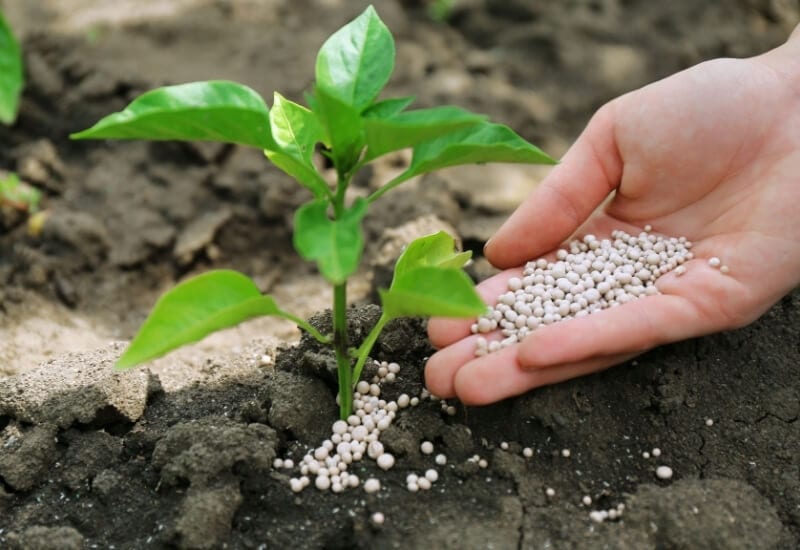
Now you have seen the main differences between perlite and vermiculite, let’s look at minor ones, like pH. I told you that this article would be very thorough indeed!
Perlite’s PH And How It Changes It In The Soil
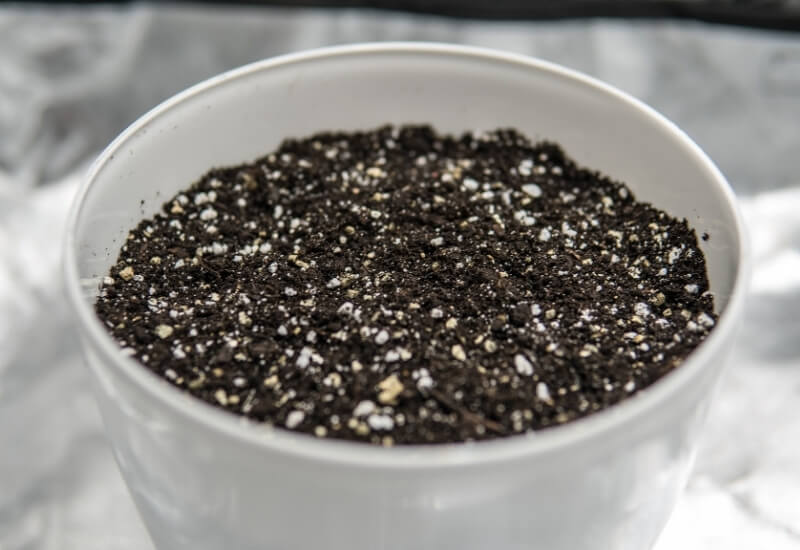
Perlite has a pH between 7.0 and 7.5. As you know, 7.0 is neutral, and 7.5 is very slightly alkaline. This means that you can use perlite to correct acidic soil. It is not a strong corrector like limestone, but it can do the trick for small corrections.
If the soil is very alkaline (over 8.0), however, perlite can have a light effect in the other direction, of lowering the overall soil environment pH.
Having said this, perlite does not interact much with the soil, from a chemical point of view. This means that these effects are light, mechanical and not chemical.
Vermiculite’s PH And How It Changes It In The Soil
Vermiculite has a wide pH range, from 6.0 to 9.5. It really depends on the mine it cones from. If you are in doubt, do choose a type of vermiculite with neutral pH. The pH will be on the description, it is a really important “detail”.
However, this gives vermiculite another advantage. Vermiculite can be a very good pH corrector. Given the vast range of pH it has and the fact that, unlike perlite, vermiculite interacts with the soil more actively.
This leads us to the next point though…
Perlite And Vermiculite With Plant Nutrients
Perlite and vermiculite also have another difference when it comes to the nutrients they have and release. This can make a big difference in your choice.
But first of all, a technical concept: CEC, or Cation Exchange Capacity. What is it? A cation is the chemical form in which nutrients dissolve into water. They break up into electrically charged smaller parts, called cations.
The capacity of a material to exchange cations means that how much it can feed plants… and guess what?
Perlite And Nutrients
Perlite does have some nutrients in its pebbles, but it does not give them to the soil or the plants.
Perlite has no CEC. You see, as we said, perlite does not interact with the soil or potting mix you put it with.
Vermiculite And Nutrients
On the other hand, vermiculite will release nutrients to the soil and to your plants. In fact, vermiculite has very high CEC.
It actually has a CEC, so the capacity to “feed plants” which is higher than sphagnum peat and not too much lower than that super feeder we all know and love: humus!
What does it mean? It means that it has nutrients, especially calcium, magnesium and potassium which it will give to your plants.
Good, isn’t it? Not necessarily. If a plant gets too much of a nutrient, it becomes sick, this is a condition called nutrient toxicity. In plants like hemp, for example excess of potassium will turn the leaves rusty brown.
This is particularly important in hydroponic gardening, where the amount of nutrients you give you’re your plants needs to be just right, and vermiculite may interfere with this.
How To Use Perlite And Vermiculite
Once you have chosen between perlite and vermiculite the one that is best for you and your plants, you may want to know a few basics on how to use them, right?
To start with mix perlite and / or vermiculite into the soil, potting mix or growing medium. There are gardeners who swear you can use vermiculite on its own for seedlings, but this is not tested, so, avoid it.
How much should you mix in? As much as you need, of course, but as a general rule don’t exceed 50% perlite or vermiculite in your soil, potting mix or growing medium. The rest can be compost, peat (substitute) or just soil etc. But keep in mind that these are soil improvers, they are not soil!
In the ground and in pots, if it rains a lot, you may find that perlite tends to come back onto the surface… That happens especially if the soil is bare. Where there are roots, these will tend to hold the perlite in place. But if you have this problem, just dig it back in as soon as you have the opportunity.
Also remember that both perlite and vermiculite come in different sizes. Usually these are small, medium and large. Choose the one that nest suits the consistency you want your soil, potting mix or growing medium to have.
If you want a thin and loose texture, choose small, if you want a more chunky one, choose large. Also adapt to the size of the pots and containers if you wish.
Still, if you really want to break down clay or chalk, choose small size perlite. It is better at breaking down these types of soil because water makes them “clump up”, and the smaller the pebbles you add, the more they make the overall texture fine and loose.
The Price Of Perlite And Vermiculite
How much do vermiculite and perlite cost? On the whole vermiculite is cheaper than perlite. First of all though, buy them in liters, not weight! The weight will change with humidity. Do not trust any seller that says, “I’ll give you a hundred grams for…”
Always buy dry vermiculite, it must be sealed in airtight containers. Remember that it swells with humidity!
Finally, at the time of writing, 10 liters of vermiculite should cost you less than $10, even half that. Perlite can easily go above that.
And now you know everything about perlite and vermiculite! Or are there any other questions? I see that there are…
Perlite vs. Vermiculite Frequently Asked Questions And Answer
Of course there are lots of questions on such technical materials like perlite and vermiculite… Here they are, with full answers of course.
Are There Any Handling Precautions?
Good question. You don’t need to wear gloves or anything. But with perlite, it’s better if you spray it with water before you handle it.
Why? Well simply it is dusty, and that dust can end up in your mouth and nose. It’s not dangerous but it is actually quite annoying and even irritating. Alternatively, wear a mask.
Do Perlite And Vermiculite Support The Plants’ Health?
Yes, they do in different ways. Aeration of course is essential to healthy plants, but talking about vermiculite, it also seems to attract beneficial bugs! Yes, they love the moisture in the soil it retains, so it actually improves the ecosystem.
If I Buy Perlite Or Vermiculite, How Long Will They Last Me?
They are rocks, so they will last forever. It is as simple as that!
Can I Use Perlite And Vermiculite Outdoors?
Of course you can, though it may not be economical to do so. Especially for small gardens though, you can. Vermiculite is more used outdoors than perlite is though.
Do Perlite And Vermiculite Float?
Excellent question, especially if you are thinking hydroponics.
Let’s start with vermiculite. It’s a strange story. It is lighter than water, but it does not float. No, it’s not against physics… It fills with water, remember, so, as soon as it touches it, it gets heavy and sinks.
Perlite on the other hand floats. This means that if you want to use it in hydroponics it can be a little problem. People like to block it into coconut coir, or similar materials which can trap it and keep it under water.
Can I Use Perlite And Vermiculite Together?
Yes, of course you can use both vermiculite and perlite together! And many hydroponic gardeners like this mix. Adding vermiculite to perlite to increase water retention while keeping perfect aeration seems like a perfect solution.
Can I Use Constriction Perlite Or Vermiculite?
Remember? We said that both perlite and vermiculite are also used in other sectors, like building and construction.
If you go online and you look for perlite or vermiculite to buy, you will find huge quantities at low prices as well as smaller quantities at higher prices. Why?
The big bags are for builders! They mix them in with concrete etc…
But there is a huge problem; these are not clean, often there are many other materials mixed in.
And in many cases, these materials are not “inert”, so they can harm your plants. Actually, there have been cases of cheap construction perlite and vermiculite that was mixed with asbestos!
So, don’t go cheap; choose horticultural perlite and horticultural vermiculite, for your garden’s sake and even your health.

Written By
Amber Noyes
Amber Noyes was born and raised in a suburban California town, San Mateo. She holds a master’s degree in horticulture from the University of California as well as a BS in Biology from the University of San Francisco. With experience working on an organic farm, water conservation research, farmers’ markets, and plant nursery, she understands what makes plants thrive and how we can better understand the connection between microclimate and plant health. When she’s not on the land, Amber loves informing people of new ideas/things related to gardening, especially organic gardening, houseplants, and growing plants in a small space.

I enjoy an intelligently written article. Thank you Ms. Noyes. Took 4 pages of notes in my plant notebook.
This is the best writting. its beautifully explained and iam so much impressed with this information